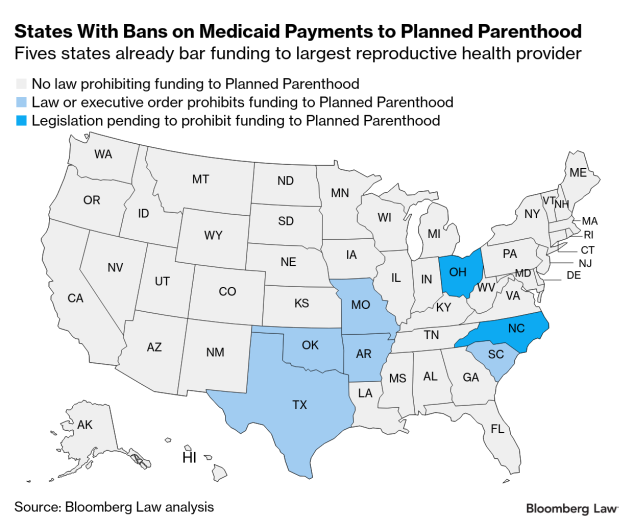State lawmakers are forging ahead with proposals to disenroll Planned Parenthood from their Medicaid programs, emboldened by the Trump administration’s federal cuts and the US Supreme Court’s defense of states’ right to legislate on the issue.
North Carolina’s House could soon take up a state Senate-passed bill (HB 192) that would discontinue any Medicaid funding to Planned Parenthood. At the same time, the Ohio legislature is advancing a measure (HB 410) to prohibit Medicaid funding to abortion care providers that as of Wednesday are prohibited for one year from receiving federal reimbursements under the Trump administration’s federal spending law.
The bills stem from a multiyear campaign by the anti-abortion movement to remove taxpayer funding for abortion providers. Over the past decade, at least 14 states have tried to remove Planned Parenthood from their state Medicaid program. Of those states, five have successfully enacted laws or issued executive orders to disqualify the organization: Arkansas, Missouri, Oklahoma, South Carolina, and Texas.
The movement to add more states to that list was strengthened by the federal funding pause and the Supreme Court’s ruling over the summer allowing South Carolina to enforce its ban on Medicaid funding to Planned Parenthood.
Democratic-led states are attempting to take on patients from states threatened by cuts at the federal and state levels. Policy analysts and providers, however, say this won’t be enough to prevent higher rates of sexually transmitted infections, undiagnosed cancers, and other negative health outcomes as the country sees a growing divide in how states are prioritizing access to reproductive health, vaccinations, and other care.
“By restricting funding at both the federal and state level, you’re allowing for these ripple effects where patients are harmed, health outcomes are harmed, especially in these states that are already facing clinician shortages,” said Suhasini Ravi, a senior associate at the Center for Health Policy and the Law at Georgetown University’s O’Neill Institute and former director for health policy of the White House Gender Policy Council under the Biden administration.
Planned Parenthood has received funding from Bloomberg Philanthropies, the charitable organization founded by Michael Bloomberg. Bloomberg Law is operated by entities controlled by Michael Bloomberg.
Defunding Campaign
Anti-abortion groups secured a win with the passage of the one-year pause on federal Medicaid reimbursements to centers that offer abortion care and received more than $800,000 from Medicaid in 2023.
Sarah Zagorski, senior director of public relations and communications for Americans United for Life, said in an email that “the federal defunding provision bolsters and encourages what states are already doing—making a policy decision that it is inappropriate for taxpayer dollars to go to those who intentionally terminate life.”
The Hyde Amendment already prohibits the use of federal funding for abortions, and Planned Parenthood affiliates maintain that any taxpayer dollars only go toward Medicaid-eligible family planning services.
Ohio state Rep. Adam Mathews (R), one of the primary sponsors on the legislation there, said in a House Medicaid Committee hearing Sept. 30 that “if the federal government is unwilling or unable to fund these entities, the state should not be expected to do so alone.”
Anti-abortion groups were also encouraged by the Supreme Court’s June ruling in Medina v. Planned Parenthood South Atlantic. The court ruled in the 6-3 decision that Medicaid beneficiaries don’t have a right to sue state programs for refusing to pay for services offered by abortion providers.
The legislation in North Carolina specifically references both the federal Medicaid funding pause and the Medina ruling as a basis to explicitly bar Planned Parenthood from the state’s Medicaid program.
Services Under Threat
Due to the federal cuts, Planned Parenthood’s affiliate in North Carolina has stopped accepting Medicaid as a form of payment, and an Ohio affiliate has already reduced its workforce. They’re both unsure if they can treat Medicaid patients beyond next year if the state bills move forward.
The North Carolina legislation, if passed, would prohibit Medicaid beneficiaries in the state from using their insurance at Planned Parenthood after the federal provision expires in 2026 or if it’s ultimately blocked by courts, said Jillian Riley, the North Carolina director of public affairs for Planned Parenthood South Atlantic.
“It would mean that cancers will go undetected, STIs will go untreated, and people won’t be able to get the birth control they need to plan their families and their futures,” Riley said in an interview.
Planned Parenthood of Greater Ohio has been forced to lay off staff in recent months due to the federal cuts. Approximately 40% of the affiliate’s patients, or roughly 22,000, are covered by Medicaid.
The passage of HB 410 means “there will be patients who aren’t able to pay and won’t be able to be seen at Planned Parenthood,” said Lauren Blauvelt, executive director of Planned Parenthood Advocates of Ohio.
Blauvelt said that in Ohio, there aren’t enough alternative providers ready to take on Planned Parenthood patients. Ohio isn’t alone in this, with three states that already prohibit Medicaid funding to Planned Parenthood—Arkansas, Missouri, and Oklahoma—listed among the top six states with the highest percentage of maternity care deserts in the March of Dimes’ latest annual report.
Katie Keith, director of the Center for Health Policy and the Law at the O’Neill Institute, said that as states also grapple with nearly $1 trillion in federal cuts to Medicaid and an emerging patchwork of immunization guidance, the country can expect an ever-growing divide in how populations access the health-care system.
“This is just among one of the many things that’s going to continue to exacerbate differential access and cost and outcomes and health-care workforce issues between states,” Keith said.
To contact the reporter on this story:
To contact the editors responsible for this story:
Learn more about Bloomberg Law or Log In to keep reading:
See Breaking News in Context
Bloomberg Law provides trusted coverage of current events enhanced with legal analysis.
Already a subscriber?
Log in to keep reading or access research tools and resources.

